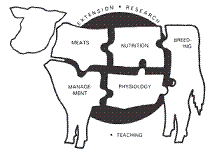Animal Science, Department of

Nebraska Beef Cattle Reports
Date of this Version
January 2000
Abstract
Nine ruminally fistulated yearling steers were used in a 9 x 2 Incomplete Latin square to evaluate benefits of an increase in dietary Rumensin level during an imposed acidosis challenge. Feeding Rumensin, at either 30 or 45g/ ton reduced acidosis on the challenge day. However, increasing the dietary Rumensin concentration to 45g/ton was required to reduce acidosis for the five days following that challenge. Feeding 45g/ton reduced ruminal pH area below 5.6 when compared to the normal level of 30g/ton during the five days following the challenge.


Comments
Published in Nebraska Beef Cattle Report 2000, published by Agricultural Research Division, University of Nebraska Cooperative Extension, and Institute of Agriculture and Natural Resources, University of Nebraska–Lincoln.